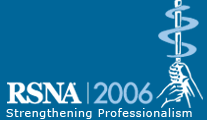
Abstract Archives of the RSNA, 2006
SST06-03
Prevalence of Anatomical Variants and Coronary Anomalies in 202 Consecutive Patients by 64-slice CT Coronary Angiography
Scientific Papers
Presented on December 1, 2006
Presented as part of SST06: Cardiac (CT)
Ludovico La Grutta MD, Presenter: Nothing to Disclose
Roberto Malag˛ MD, Abstract Co-Author: Nothing to Disclose
Anselmo Alessandro Palumbo MD, Abstract Co-Author: Nothing to Disclose
Willem Bob Meijboom MD, Abstract Co-Author: Nothing to Disclose
Nico R Mollet MD, Abstract Co-Author: Nothing to Disclose
Filippo Cademartiri MD, PhD, Abstract Co-Author: Nothing to Disclose
To assess the prevalence of variants and anomalies of coronary artery tree in patients who underwent 64-slice CT Coronary Angiography (CT-CA).
202 patients (146 male, mean age 60±11) who underwent 64-slice CT-CA for suspected coronary artery disease were reviewed for coronary artery variants and anomalies. Segments were classified according to the American Heart Association scheme.
Anatomical variants of coronary artery are extremely frequent. The coronary dominance pattern resulted: right 87%, left 7% and balanced 6%. The left main coronary artery had a mean length of 104±50. The intermediate branch was present in the 17% of the cohort.
A variable number of diagonals (1 in the 24%, 2 in the 50%, >2 in the 26%) and marginals (1 in the 37%, 2 in the 47%, >2 in the 16%) was visualized. Furthermore, CT-CA may visualize smaller branches such as the conus branch artery (origin from RCA in the 59%, from RCA ostium in the 26% or from aorta in the 13%; not detected in the 2%), the sinus node artery (from RCA in the 64%, from LCX in the 15%, both pathways present in the 10%; not detected 11%) and the septal branches (89%).
51 patients presented single or associated coronary anomalies with the following distribution: 25 anomalies of origin and course, 32 intrinsic coronary anomalies (28 myocardial bridging, 4 aneurisms), 1 fistula.
64-slice CT-CA is able to image the variable and complex anatomy of coronary arteries because of the high spatial resolution and flexible post-processing tool such as MPR, VR and MIP. CT-CA can easily define normal anatomical variants from potentially dangerous anomalies.
The identification of coronary variants and anomalies may support clinical management of referring cardiologists, especially in the Cath-Lab settings, and cardiac surgeons.
La Grutta, L,
Malag˛, R,
Palumbo, A,
Meijboom, W,
Mollet, N,
Cademartiri, F,
Prevalence of Anatomical Variants and Coronary Anomalies in 202 Consecutive Patients by 64-slice CT Coronary Angiography. Radiological Society of North America 2006 Scientific Assembly and Annual Meeting, November 26 - December 1, 2006 ,Chicago IL.
http://archive.rsna.org/2006/4432776.html

